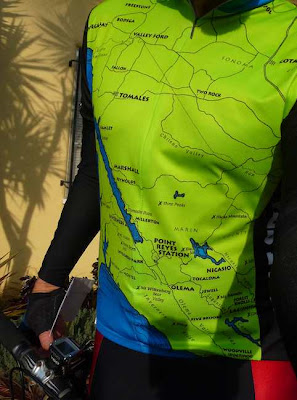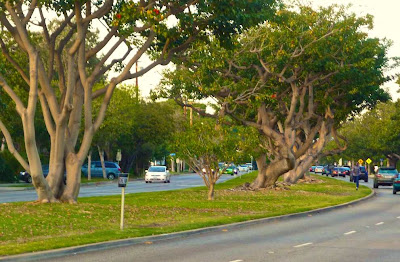West to the Sea
For my day six jersey-fest, I decided to wear my Holstein Century jersey, which I picked up in 2008. The jersey celebrates a yearly ride that explores the decidedly rural back roads of Marin and Sonoma counties, taking cyclists past beautiful Tomales Bay. The jersey also serves as a map of the area. (I plan to return in 2010 to Tomales Bay and environs to conduct a photography tour for the Point Reyes National Seashore association).

Here are a few photographs from that ride:

Because the Holstein Century traveled to the ocean, it put me in the "mooed" to ride to Ocean Avenue, along the bluffs overlooking the sea, about 11 miles from my home in Santa Monica (the "Home of the Homeless," for fans of Harry Sherer and "Le Show"). With the winter sun low in the sky I attached a rear light to my road bike, and pedaled west about 3 p.m. on Pico Blvd., crossing La Cienega Blvd. into West Los Angeles, not cowed by the traffic. This section of Pico Blvd. is lined with, among many other enterprises, a number of synagogues and Kosher restaurants; an oil well sits hidden behind a high wall and lots of trees along one entire block.
I cut north to reach Santa Monica Blvd., where I rode by the impressive Los Angeles California Temple, the largest Mormon temple after the Mother Ship temple headquarters in Salt Lake City. Standing 275 feet tall, atop a small hill, the L.A. temple was supposedly, for many years after it's dedication in 1956, visible to ships at sea. Today, high rise buildings have mostly eclipsed the view from afar, but the temple is still a very impressive building, if only because of it's park-like setting.
A few miles later, I rode through an enclave of the U.S. Veterans Adminstration, which includes a hospital and a number of other medical facilities, and an amazing amount of open space, given its location in crowded West Los Angeles. Unfortunately, most of the beautiful 19th century buildings were razed by the late 1960s.

While most of the current structures are not architecturally appealing, this is a most pleasant place to cycle through, largely traffic-free. There are various schemes to radically change the character of the complex, given that there are huge open areas ripe for commercial development. From my standpoint, it would be best to leave the VA unchanged, existing as an island of calm in the middle of a bustling megalopolis.
Below is the VA's administration building. I'm guessing the edifice was once a hospital building.
Passing out the west gate of the VA, I reached the tony Brentwood community, and San Vicente Blvd; its two lanes each direction are separated by a broad grassy divider planted with coral trees. Running for five miles west to Ocean Ave., San Vicente is a favorite of cyclists and joggers.
When I reached Ocean Ave., I spent a few minutes enjoying the views off the bluffs, looking south along the broad beaches to the Santa Monica Pier, then north, toward Malibu. I saw no Holsteins, although there were lots of joggers and walkers out on the bluffs. After days of clear weather, moist air from the Pacific had moved inland, giving the coast an udderly dream-like appearance.
On the northern end of the bluffs, Adelaide Street runs east and west for perhaps half a mile. The south side of Adelaide is lined with a number of beautiful and large homes, several serving as spectacular examples of the Craftsman style of architecture. The north side of the street drops off steeply into the somewhat Bohemian Santa Monica Canyon. To reach the bottom of the canyon by car from Adelaide Street require negotiating a few serpentining streets for a couple of minutes. A direct route, however leads down either of two sets of stairs, one of concrete, one with wooden planks, separated from each other by a few hundred yards.
Long ago, when both sets of stairs were wooden, my cycling friends and I would ride down to Adelaide Street, hoist our bikes over our shoulders, and walk up and down the steps a few times. Back then - probably 30 years ago - only a few people exercised on the stairs, and we'd see the those same few people each time we were there. I can remember one man who, shirtless, would shadow-box his way up and down the wickedly steep steps.
I'm not sure why my friends and I decided to emulate these udderly ridiculous loco locals. I'm not sure why we decided to include our bikes in the enterprise. At some point, though, we found ourselves, on our rides to bluffs, doing repeat climbs into and out of the somewhat Bohemian Santa Monica Canyon, silently counting steps.
Eventually I lost my cycling friends, but I didn't stop climbing and descending the stairs for a long time. Unfortunately, for me, when the wooden planks gave way to concrete, and the width of the stairs (with 189 steps) narrowed. In addition, the stairs became insanely popular. This is the place to see beautiful bodies in motion, climbing and descending the stairs, sipping water on Adelaide, performing (the right word) crunches and push-ups on a nearby grassy strip.
Once in a great while, when they aren't crowded, I'll still hoist my bike over my shoulder and walk down and up the nearby and wider wooden stairs, still silently counting steps, a few less than those on the concrete stairs, and doing my best not to whack anybody in the endeavor with my bike. Below is the upper section of the concrete stairs.
On this late, cool afternoon, even though there weren't many stair climbers, I passed up the opportunity to walk the steps, and began riding for home, reversing much of my route. I headed back up San Vicente Blvd., along the beautiful dividing strip. I saw relatively few joggers; the few cyclists I saw were all headed down the opposite side of the roadway.
 I retraced my way through the Veterans Administration again; below is a view of the hospital that opened in 1977.
I retraced my way through the Veterans Administration again; below is a view of the hospital that opened in 1977.  I traveled back along Santa Monica Blvd., too, which features a reasonably safe bike lane, nominally keeping motorists away from cyclists.
I traveled back along Santa Monica Blvd., too, which features a reasonably safe bike lane, nominally keeping motorists away from cyclists. The bike lane ends at the eastern edge of Century City, where I stared up at a collection of office towers. The sun was about to set behind me; I'd already turned on the blinking rear light on my bike as I rode along a few quiet residential streets, in time to walk the dog and catch a beautiful sunset, another day and another jersey done.












No comments:
Post a Comment